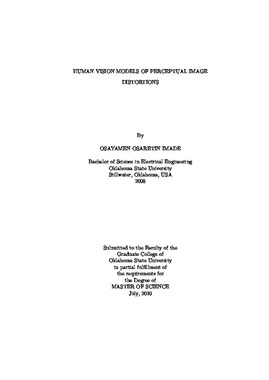| dc.contributor.advisor | Chandler, Damon M. | |
| dc.contributor.author | Imade, Osayamen Osaretin | |
| dc.date.accessioned | 2014-04-17T20:08:39Z | |
| dc.date.available | 2014-04-17T20:08:39Z | |
| dc.date.issued | 2010-07-01 | |
| dc.identifier.uri | https://hdl.handle.net/11244/10215 | |
| dc.description.abstract | Digital media's prevalence in today's society is placing an increasing strain on the technology to provide, transmit and store these contents. The demand for higher quality content in digital media has led to drastic increase in storage requirements over the past three decades. To meet the challenge of storing and securing digital media, this thesis proposes an insight into how the human vision system (HVS) can be characterized to determine thresholds of visibility of visual distortions. The use of these results can increase the amount of watermarking information applied to an image as well as applications in quantization error detection. In this thesis, we first propose a framework for predicting the regions of natural images that visually disguise distortions created as a result of modification of wavelet domain coefficients. The visual error perception algorithm adaptively predicts the visual perceptibility threshold of spread spectrum watermarking added in the wavelet subband. Spatial statistical feature maps combined with ground truth data from psychophysical experiments enabled the generation of an activity scaling parameter that evaluates the masking thresholds of image regions. We also demonstrate the correlation with an image quality assessment algorithm to the detectability of distortions in an image. Subsequently the algorithm is combined with a compression scheme to yield compressed images of higher visual quality. Secondly, we presents the results of another psychophysical experiment designed to investigate the effect of a scene's context on the detection of distortions presented in natural-image patches. Via a two-alternative forced-choice experiment, we measured thresholds for detecting 6.2 c/deg gabor target in image patches which were placed in various image surrounds (contexts), including various textures, a solid-gray background, and the patch's original context. The contexts were adjusted using histogram specification to control for differences in brightness, contrast, and other first-order statistical properties of the luminance distribution. Our results revealed that the context in which a patch is placed does indeed affect the ability to detect distortions in that patch. The findings suggest that characterization and implementation of a human visual system's ability to detect errors has potential in providing perceivable greater quality in image applications. | |
| dc.format | application/pdf | |
| dc.language | en_US | |
| dc.publisher | Oklahoma State University | |
| dc.rights | Copyright is held by the author who has granted the Oklahoma State University Library the non-exclusive right to share this material in its institutional repository. Contact Digital Library Services at lib-dls@okstate.edu or 405-744-9161 for the permission policy on the use, reproduction or distribution of this material. | |
| dc.title | Human Vision Models of Perceptual Image Distortions | |
| dc.type | text | |
| dc.contributor.committeeMember | Rahnavard, Nazanin | |
| dc.contributor.committeeMember | Piao, Daqing | |
| osu.filename | IMADE_okstate_0664M_11036.pdf | |
| osu.college | Engineering, Architecture, and Technology | |
| osu.accesstype | Open Access | |
| dc.description.department | School of Electrical & Computer Engineering | |
| dc.type.genre | Thesis | |
| dc.subject.keywords | compression | |
| dc.subject.keywords | distortion perception | |
| dc.subject.keywords | human vision | |
| dc.subject.keywords | human visual system | |
| dc.subject.keywords | image context | |
| dc.subject.keywords | image quality | |
